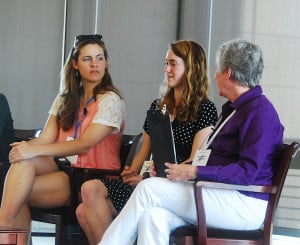Females make up 57 percent of the U.S. undergraduate population, but only 18 percent of those with degrees in computer science, according to Ellora Israni ’14 and Ayna Agarwal ’14 who gave the opening remarks Saturday at an event called She++.

The conference, the brainchild of Israni, a Daily senior staff writer, and Agarwal, was meant to probe the barriers that separate women from the technology field, in addition to serving as a call for women to enter fields and pursue passions outside of their comfort zones. Speakers at the event included Jocelyn Goldfein, director of engineering at Facebook; Irene Au, head of user experience at Google; and Maria Klawe, president of Harvey Mudd College.
Both Israni and Agarwal said they were influenced to found the event by a small presentation they attended last fall by Facebook COO Sheryl Sandberg.
“If we were able to be inspired by something like [Sandberg’s presentation], why not bring a host of role models to campus to inspire a larger audience of women?” Israni said.
Interested high school and Stanford students were admitted to the conference for free, and all available tickets were booked days after release.
One of the attendees was Michelle Pan ’15, who is considering majoring in computer science.
“I thought [She++] would be relevant to my life in the next four years and even beyond [Stanford],” she said.
Pan described the conference as insightful in helping her understand the role that women can play in the computer science world.
“I found it helpful that all the speakers came from different backgrounds,” she said. “It was easy to find someone to connect to and find a new perspective.”
The She++ team will post blog posts by attendees and videos of the panel speakers online for those who could not secure tickets to the Saturday event.
“The point of this was to bring the [She++] community onto the Internet for the rest of the Bay Area – and the nation – to see,” Agarwal said.
During the panel, Goldfein explained why there is such enthusiasm to promote computer science for women. If the gender balance among computer scientists could match the regular college distribution, there would be a doubling of computer scientists in America, she said.
Computer Science professor Eric Roberts told The Daily in February that only 20 percent of CS majors currently at Stanford are women.
The She++ conference also focused on the reasons behind the abysmally low numbers of female computer scientists and engineers. Female engineers face the “Imposter Syndrome,” the insecurity that they do not belong in an area so heavily occupied by males.
Keynote speaker Klawe offered a solution that she said has raised Harvey Mudd’s percentage of female computer scientists to 40 percent.
According to Klawe, using the K-12 SWIFT Career Interest Study 1998-1999, Harvey Mudd found that from an early age, women have a significantly smaller interest and lower confidence level in computer science and engineering. Additionally, this gender gap does not change throughout the years.
“It’s a problem based on the old saying ‘Do what you love and what you are good at,’” Klawe said in her keynote speech. She added that if women are not interested and are not confident, they will not pursue computer science.
In order to fix this gap, Harvey Mudd reconstructed their introductory computer science course from the standard Java curriculum into a group-focused Python learning experience. This course was further divided based on the experience-level of each student so new students were not dissuaded by their peers who were seemingly more experienced. CS 106A, Stanford’s introductory CS class, is taught in Java.
“[Israni] and I really want to do something after this,” Agarwal said. “It’s just a matter of figuring out what. But, I feel like I have a responsibility to continue doing something with this experience.”
“I think we can view this conference for a day, but the impact needs to last longer than that,” Israni said. “Whether it’s pointing people to other places or organizing them ourselves, we’re definitely going to continue.”